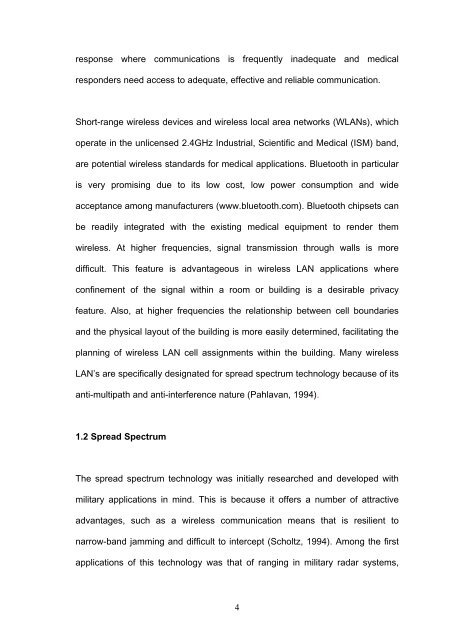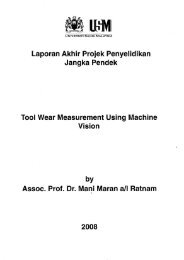design and development of a secure wireless ... - ePrints@USM
design and development of a secure wireless ... - ePrints@USM
design and development of a secure wireless ... - ePrints@USM
You also want an ePaper? Increase the reach of your titles
YUMPU automatically turns print PDFs into web optimized ePapers that Google loves.
esponse where communications is frequently inadequate <strong>and</strong> medical<br />
responders need access to adequate, effective <strong>and</strong> reliable communication.<br />
Short-range <strong>wireless</strong> devices <strong>and</strong> <strong>wireless</strong> local area networks (WLANs), which<br />
operate in the unlicensed 2.4GHz Industrial, Scientific <strong>and</strong> Medical (ISM) b<strong>and</strong>,<br />
are potential <strong>wireless</strong> st<strong>and</strong>ards for medical applications. Bluetooth in particular<br />
is very promising due to its low cost, low power consumption <strong>and</strong> wide<br />
acceptance among manufacturers (www.bluetooth.com). Bluetooth chipsets can<br />
be readily integrated with the existing medical equipment to render them<br />
<strong>wireless</strong>. At higher frequencies, signal transmission through walls is more<br />
difficult. This feature is advantageous in <strong>wireless</strong> LAN applications where<br />
confinement <strong>of</strong> the signal within a room or building is a desirable privacy<br />
feature. Also, at higher frequencies the relationship between cell boundaries<br />
<strong>and</strong> the physical layout <strong>of</strong> the building is more easily determined, facilitating the<br />
planning <strong>of</strong> <strong>wireless</strong> LAN cell assignments within the building. Many <strong>wireless</strong><br />
LAN’s are specifically <strong>design</strong>ated for spread spectrum technology because <strong>of</strong> its<br />
anti-multipath <strong>and</strong> anti-interference nature (Pahlavan, 1994).<br />
1.2 Spread Spectrum<br />
The spread spectrum technology was initially researched <strong>and</strong> developed with<br />
military applications in mind. This is because it <strong>of</strong>fers a number <strong>of</strong> attractive<br />
advantages, such as a <strong>wireless</strong> communication means that is resilient to<br />
narrow-b<strong>and</strong> jamming <strong>and</strong> difficult to intercept (Scholtz, 1994). Among the first<br />
applications <strong>of</strong> this technology was that <strong>of</strong> ranging in military radar systems,<br />
4

















